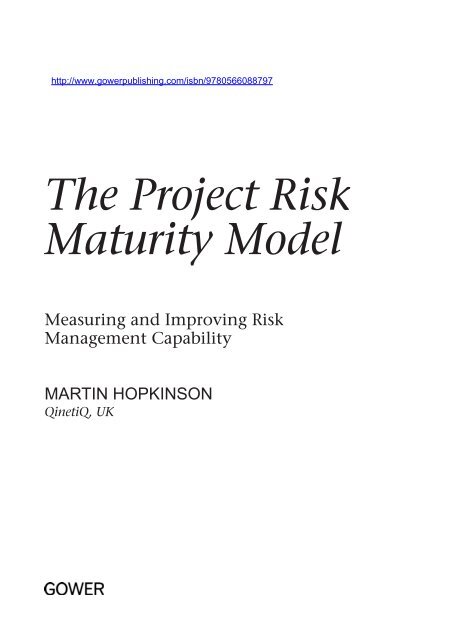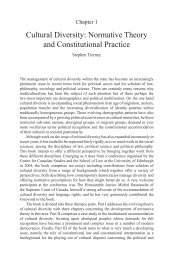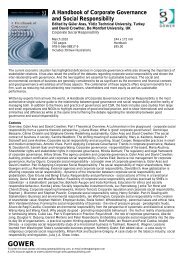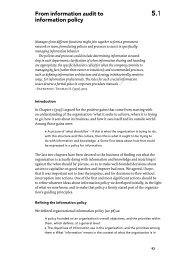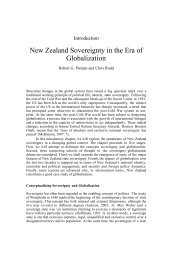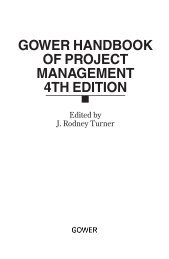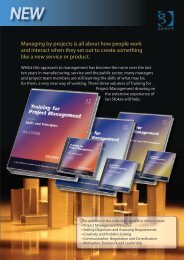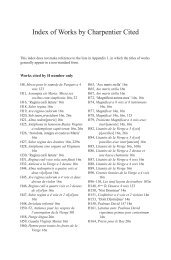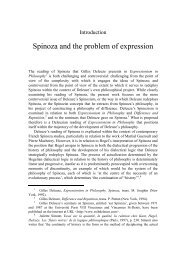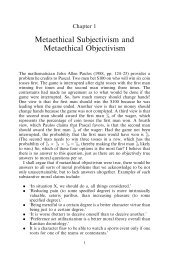The Project Risk Maturity Model
The Project Risk Maturity Model
The Project Risk Maturity Model
You also want an ePaper? Increase the reach of your titles
YUMPU automatically turns print PDFs into web optimized ePapers that Google loves.
<strong>The</strong> <strong>Project</strong> <strong>Risk</strong><br />
<strong>Maturity</strong> <strong>Model</strong><br />
Measuring and Improving <strong>Risk</strong><br />
Management Capability<br />
Martin Hopkinson<br />
QinetiQ, UK
chapter<br />
1 <strong>The</strong> <strong>Project</strong> <strong>Risk</strong> <strong>Maturity</strong><br />
<strong>Model</strong><br />
A <strong>Risk</strong> <strong>Maturity</strong> <strong>Model</strong> (RMM) is a tool designed to assess risk management capability. <strong>The</strong><br />
<strong>Project</strong> RMM software provided with this book will allow its user to assess the capability<br />
of the risk management process being applied on any project. It will also allow capability<br />
improvements to be assessed and for the capabilities of different projects to be compared.<br />
However, assessing risk management capability is not a simple task. Obtaining reliable<br />
results requires an assessor (or auditor) who has insight into the subtleties of project risk<br />
management; what is best practice for one project might be inappropriate to another.<br />
This book has been written to describe the issues facing anyone tasked with assessing<br />
project risk management capability. Whilst it is possible for any owner of the <strong>Project</strong><br />
RMM software to load it onto their computer and start their assessment process forthwith,<br />
following the guidance in this book should provide them and their organisation with a<br />
sounder basis for believing the results.<br />
By way of introduction, the rest of this chapter describes how the <strong>Project</strong> RMM<br />
has been constructed and how its results should be interpreted. Subsequent chapters<br />
then describe the issues that assessors should understand before putting the RMM into<br />
action or making recommendations for process improvement. <strong>The</strong> section ‘Software User<br />
Instructions’ at the end of the book (pp. 235–42), provides user instructions for how the<br />
<strong>Project</strong> RMM software should be installed and used.<br />
<strong>The</strong> <strong>Project</strong> <strong>Risk</strong> <strong>Maturity</strong> <strong>Model</strong> (RMM)<br />
<strong>The</strong> <strong>Project</strong> RMM was first developed by HVR Consulting Services in 1999. Its fourlevel<br />
capability structure, illustrated in Figure 1.1 is derived directly from the structure<br />
developed by David Hillson (1997) who used it to establish a generic <strong>Risk</strong> <strong>Maturity</strong><br />
<strong>Model</strong> framework. <strong>The</strong> matrix for assessments identified by Hillson’s paper published in<br />
the International Journal of <strong>Project</strong> and Business <strong>Risk</strong> Management has been reproduced in<br />
Appendix A.<br />
In order to adapt the Hillson <strong>Risk</strong> <strong>Maturity</strong> <strong>Model</strong> for project-specific purposes, the<br />
following additional sources were used:<br />
• Standard risk management guides, most notably the <strong>Project</strong> <strong>Risk</strong> Analysis and Management<br />
(PRAM) Guide (1997) published by the Association for <strong>Project</strong> Management (APM).<br />
• <strong>The</strong> project risk management literature published in academic journals and books.
T h e P r o j e c t R i s k M a t u r i t y M o d e l<br />
Level 4:<br />
Natural<br />
Level 3:<br />
Normalised<br />
Level 2:<br />
Novice<br />
Level 1:<br />
Naive<br />
Figure 1.1<br />
<strong>Risk</strong> maturity model levels<br />
• <strong>The</strong> Turnbull Guidance (1999) – Internal Control: Guidance for Directors on the Combined<br />
Code.<br />
• <strong>The</strong> experience, dating back to 1987, of risk management consultants working for<br />
HVR Consultancy Services.<br />
Since its creation the <strong>Project</strong> RMM has continued to evolve in response to lessons<br />
learned from its application. To date, it has been used for approximately 250 assessments<br />
on projects with an estimated combined value in excess of £60 Billion. Changes have<br />
also been made in response to new literature on the subject. Later chapters in this book<br />
identify the sources that have been the most influential. <strong>The</strong> software on the CD ROM<br />
included with this book is the latest version (version no. 6.0.0) of the model, updated in<br />
2010.<br />
<strong>The</strong> definitions of each level of project risk management capability are:<br />
Level 1 – Naïve<br />
Although a project risk management process may have been initiated, its design or<br />
application is fundamentally flawed. At this level, it is likely that the process does not<br />
add value.<br />
Level 2 – Novice<br />
<strong>The</strong> project risk management process influences decisions taken by the project team in<br />
a way that is likely to lead to improvements in project performance as measured against<br />
N. Turnbull et al., Internal Control: Guidance for Directors on the Combined Code, hereafter referred to as the Turnbull<br />
Guidance or the Turnbull Report.
T h e P r o j e c t R i s k M a t u r i t y M o d e l<br />
<br />
its objectives. However, although the process may add value, weaknesses with either the<br />
process design or its implementation result in significant benefits being unrealised.<br />
Level 3 – Normalised<br />
<strong>The</strong> project risk management process is formalised and implemented systematically.<br />
Value is added by implementing effective management responses to significant sources<br />
of uncertainty that could affect the achievement of project objectives.<br />
Level 4 – Natural<br />
<strong>The</strong> risk management process leads to the selection of risk-efficient strategic choices<br />
when setting project objectives and choosing between options for project solutions or<br />
delivery. Sources of uncertainty that could affect the achievement of project objectives<br />
are managed systematically within the context of a team culture conducive to optimising<br />
project outcomes.<br />
Advancing through <strong>Project</strong> RMM <strong>Maturity</strong> Levels<br />
RMM Level 1 could describe a project that is not implementing any process for managing<br />
risk. This would include projects that claim to be implicitly managing risk by virtue of<br />
the effectiveness of other project management processes such as planning (thus ignoring<br />
the fact that deterministic project management processes such as planning are not<br />
designed to manage the implications of uncertainty). However, since it would be unusual<br />
for projects to undergo RMM assessments when they have no formal risk management<br />
process, the more common cause of RMM Level 1 assessment results is a fundamental<br />
flaw with the design or application of the process. In practice, most problems at this level<br />
amount to failures of application. Whilst a risk management process might have been<br />
initiated, allowing any of its critical components to lapse into disuse will result in the<br />
overall process adding no value, hence producing a Level 1 assessment.<br />
Once a project has taken professional advice or followed standard guidance to initiate<br />
its process, moving to a Level 2 RMM capability should be a relatively easy target to<br />
achieve. Level 2 does not set a particularly demanding standard. In effect, it requires<br />
that the value added by applying the risk management process should be greater than<br />
the cost and other resource implications of its application. Thus, even a relatively light<br />
application of the process can be sufficient to achieve this level.<br />
<strong>The</strong> step-change difference between Level 2 and Level 3 RMM capability is mainly<br />
attributable to two factors: the discipline of implementing the process consistently across<br />
the whole project and the quality with which key skills are applied in practice.<br />
A project will be able to achieve RMM Level 3 with the simple common-practice<br />
approach of using a risk register to underpin routine reviews of the implications of risks<br />
and the effectiveness and implementation of the responses designed to manage them.<br />
Although this is a simple process, there are a number of important skills involved in<br />
exploiting its potential to the full. For example, risks must be understood in a way that<br />
clarifies all relevant and significant sources of uncertainty. Failure to do this will impair<br />
the effectiveness of risk responses. Similarly, there are key skills involved in making sure
T h e P r o j e c t R i s k M a t u r i t y M o d e l<br />
that risk register contains the right risks, (and that they continue to be the right risks),<br />
that they are managed by the right risk owners, and that appropriate and sound methods<br />
are used to select and prioritise risks for review.<br />
Although RMM Level 3 can be achieved with a simple process, application of the<br />
process must also be broad, continuous and sound. <strong>The</strong> process must actively engage all<br />
relevant members of the team and key stakeholder representatives. A key enabler of RMM<br />
Level 3 is the disciplined application of the process by risk owners. This discipline can<br />
usually only be maintained through regular risks reviews.<br />
In practice, larger projects often have more difficulty achieving RMM Level 3 than smaller<br />
projects. Whilst they might find the process easier to initiate, issues of process application<br />
tend to be more common. Larger projects can also find it more difficult to correct issues of<br />
process design, particularly if the tools that they have invested in have insufficient flexibility.<br />
Thus, whilst smaller projects might have more difficulty initiating a risk management process,<br />
they often achieve RMM Level 3 in a relatively short period of time.<br />
<strong>The</strong> biggest step change in the <strong>Project</strong> RMM lies in the difference between Level 3 and<br />
Level 4. Achieving Level 4 requires the risk management process to be capable of leading<br />
to ‘the selection of risk-efficient strategic choices when setting project objectives and<br />
choosing between options for project solutions or delivery’. Whereas Level 3 capability<br />
requires the risk management process to support the ‘achievement of project objectives’,<br />
Level 4 capability makes it possible for risk management to contribute to decisions that<br />
set the project objectives in the first place. Similarly, where RMM Level 3 capability would<br />
typically identify responses to risks associated with a pre-existing project plan, Level 4<br />
capability supports choices about the project solution; choices that can alter plans so<br />
fundamentally that they are, effectively, entirely different plans. Level 4 risk management<br />
capability therefore includes the management of risk from a project strategy perspective.<br />
Whereas RMM Level 3 supports a process designed to ‘deliver the project right’, Level 4<br />
helps to provide assurance that the planned project is ‘the right project’.<br />
<strong>The</strong> step from RMM Level 3 to Level 4 requires a change of mindset and the level of<br />
management at which risk decisions are supported. <strong>The</strong> power to authorise project objectives<br />
and fundamental changes to the project solution (for example, its products, utilisation of<br />
the organisation’s resources or the choice of parties to be involved) is usually vested in the<br />
project sponsor rather than the project manager. Executing the right risk responses from<br />
this level makes significant demands on both the organisation’s risk management culture<br />
and the project’s ability to provide relevant and realistic risk information.<br />
Stepping up from RMM Level 3 to Level 4 usually also requires the use of more<br />
sophisticated risk management techniques. For example, at Level 4, it is necessary to<br />
quantify risk at the overall project level. Since risk management offers a wide range of<br />
techniques Level 4 capability requires people with the ability and experience to select the<br />
techniques that are appropriate to the project concerned.<br />
One consequence of the need for different techniques is that simple techniques used to<br />
achieve Level 3 capability can prove to be too simplistic to support RMM Level 4. Temptation<br />
to over-exploit their use can thus become a barrier to achieving Level 4 capability. Perhaps<br />
the most common examples of incorrect exploitation are the Probability-Impact Matrix and<br />
the use of integrated risk register/Monte Carlo risk analysis tools. Chapter 8 (<strong>Risk</strong> Analysis,<br />
pp. 150–61) provides readers with explanations for this comment.<br />
If the difficulties of achieving RMM Level 4 capability can be overcome, there are<br />
many benefits to be gained. An organisation with a Level 4 capability across all of its
T h e P r o j e c t R i s k M a t u r i t y M o d e l<br />
<br />
projects should find that not only more of its projects are delivered to plan, but that they<br />
are also more likely to have adopted the right project strategy when being planned. <strong>Risk</strong><br />
management solutions will have been built into projects from the outset. Moreover, the<br />
techniques required for best practice are not always complex or time-consuming. Indeed,<br />
in the earliest stages they might be very simple (albeit not simplistic). What is required is<br />
that the right things are done by the right people at the right time.<br />
<strong>Risk</strong> <strong>Maturity</strong> <strong>Model</strong> Questions<br />
<strong>The</strong> <strong>Project</strong> RMM contains 50 questions, each one of which can yield information about a<br />
project’s risk management process from one or more perspectives. For example, Question<br />
C2 (see Chapter 8, pp. 134–5) asks: ‘How effectively do risk owners fulfil their role?’<br />
Since risk owners are responsible for managing their risks, the answer to this question<br />
will yield information about whether or not risks are properly understood (a key aspect<br />
of risk analysis) responded to effectively and whether or not the project has a good risk<br />
management culture. <strong>The</strong> model is based on a structure of six perspectives:<br />
1.<br />
2.<br />
3.<br />
4.<br />
5.<br />
6.<br />
<strong>Project</strong> stakeholders,<br />
risk identification,<br />
risk analysis,<br />
risk responses,<br />
project management, and<br />
risk management culture.<br />
Each of the fifty <strong>Project</strong> RMM questions is detailed in Chapters 6 to 11. <strong>The</strong> assessor<br />
selects the level of performance being achieved by the project in respect of each question.<br />
<strong>The</strong> options for each question range from A (Level 4) through to D (Level 1). Occasionally,<br />
a question may be inapplicable to the project concerned. If the ‘not applicable’ option is<br />
selected, the question is disregarded in the calculation of results; in effect the question is<br />
neutralised. When answers to all 50 questions have been selected, the RMM results can<br />
be viewed in bar chart form as illustrated in Figure 1.2. <strong>The</strong> bar chart bar heights reflect<br />
the capability level from each perspective. If all answers were to be assessed as being A,<br />
all six bars would touch the top of the bar chart. In contrast, if all answers were assessed<br />
as being D, no bars would be visible since each would be calculated as being zero. <strong>The</strong><br />
calculations use a system of weightings that reflects the relevance of each question to one<br />
or more RMM perspectives. <strong>The</strong> relative importance of questions within each perspective<br />
is also reflected in the weightings.<br />
Assessing Overall <strong>Risk</strong> Management Capability<br />
<strong>The</strong> overall assessment of risk management capability is equal to whichever is the<br />
weakest of the six perspectives. Figure 1.2 illustrates this approach by showing the overall<br />
assessment to be level with the top of the risk responses bar (the weakest perspective in<br />
this case).
T h e P r o j e c t R i s k M a t u r i t y M o d e l<br />
100%<br />
Level 4<br />
75%<br />
Level 3<br />
50%<br />
25%<br />
Level 2<br />
Overall<br />
Asessment<br />
Level 1<br />
Stakeholders <strong>Risk</strong> <strong>Risk</strong> <strong>Risk</strong> <strong>Project</strong> Culture<br />
Idnentification Analysis Responses Management<br />
Figure 1.2<br />
Example of the results from a <strong>Project</strong> RMM Assessment<br />
This method used to assess overall risk management capability has two advantages.<br />
First, it resolves any ambiguity produced by results that show different levels of capability<br />
from amongst the six perspectives (something that is very common in practice). Second,<br />
it identifies where to focus the priorities for process improvement. For example, in the<br />
case of the project assessment shown in Figure 1.2, the priorities for improvement would<br />
concern risk responses. Improvements to the risk management culture would also be<br />
required to reach Level 3.<br />
<strong>The</strong> justification for equating the overall assessment of capability with the weakest<br />
RMM perspective is based on the principle that process capability from each of the six<br />
RMM perspectives is critical to the overall risk management process. <strong>The</strong> overall process<br />
capability therefore cannot be better than the process when assessed through any of the<br />
individual perspectives. <strong>The</strong> argument that this applies to four of the six perspectives is<br />
illustrated in Figure 1.3. This figure shows the mapping of the risk identification, risk<br />
analysis, risk response and project management perspectives to an outline of the core<br />
risk management process detailed in the APM’s PRAM Guide (2004). <strong>The</strong> PRAM Guide<br />
process is shown by the boxes and arrows, whilst its mapping to the RMM is shown by<br />
the regions bounded by dashed lines.<br />
In order to function properly, the risk management process is dependent on every<br />
one of the activities shown in Figure 1.3. For example, if risk responses were never<br />
implemented, the effort spent on other aspects of the process would be wasted, even if<br />
they were performed excellently. Equivalent arguments can be made for each of the other<br />
three RMM perspectives shown in Figure 1.3. For example, if the project management<br />
process fails to initiate the risk management process appropriately or if it fails to manage<br />
it continuously (for example, through review processes), then the risk management<br />
process will be ineffective. It will be similarly ineffective if the wrong risks are identified<br />
or if risk analysis fails to create a correct understanding of the implications of risk and<br />
how it can be managed.
Initiate<br />
<strong>Risk</strong><br />
Identification<br />
<strong>Risk</strong><br />
Analysis<br />
Identify<br />
Analyse<br />
Manage Process<br />
<strong>Project</strong><br />
Management<br />
<strong>Risk</strong><br />
Responses<br />
Plan Responses<br />
Implement Responses<br />
Figure 1.3<br />
PRAM Guide mapping for four of the RMM perspectives<br />
Engage Stakeholders in Process<br />
Initiate<br />
Identify<br />
Analyse<br />
Plan Responses<br />
Implement Responses<br />
Manage Process<br />
Figure 1.4<br />
Augmented version of the PRAM Guide process
10 T h e P r o j e c t R i s k M a t u r i t y M o d e l<br />
<strong>The</strong> argument that the stakeholders’ perspective is critical to overall project risk<br />
management capability is illustrated in Figure 1.4. This is the same process diagram as that<br />
shown in Figure 1.3, but with the role of project stakeholders in the process differentiated<br />
explicitly from the project team’s internal management of the process. <strong>The</strong> RMM thus<br />
treats the project team’s internal management of a project risk management process as<br />
being not in itself sufficient.<br />
<strong>The</strong> RMM treats the following parties as being project stakeholders:<br />
•<br />
•<br />
•<br />
•<br />
•<br />
<strong>The</strong> owning organisation (as represented by its senior management),<br />
the project’s lead customer,<br />
main (first tier) suppliers,<br />
other suppliers in the project hierarchy, and<br />
end users of the project’s products.<br />
In practice, all projects have a lead customer, even if the customer is another person<br />
(that is, the project sponsor) or another group within the same organisation. Since it<br />
is unrealistic for customers to transfer the implications of all risk to the project team,<br />
risk needs to be managed from the customer’s perspective as well as that of the project<br />
team’s. This does not imply that a project should manage its own customer’s risk;<br />
customers should manage risks that they own. Rather, it implies that it is in a project’s<br />
own interests that its customer manages risk effectively and retains, shares or transfers<br />
risk appropriately. Furthermore, the effects of many types of risk are often felt by both<br />
customers and projects. For example, schedule delay will, in different ways, affect both.<br />
<strong>The</strong>re are therefore usually significant aspects of risk in which the project and customer<br />
have a mutual interest. Failing to engage the customer in the risk management process<br />
will fail to exploit this fact. It should also be remembered that customers control the<br />
agreement of project objectives. This gives them ownership of project strategy risks<br />
associated with whether or not the project’s objectives are appropriate. Since projects<br />
may be in a position where they might be able to advise on and thus influence decisions<br />
related to setting objectives, this is another point on which there should be customer<br />
engagement in the risk management process.<br />
<strong>Project</strong>s that are reliant on the delivery by suppliers of aspects of the project that<br />
involve risk are themselves customers. <strong>The</strong> arguments above concerning the need for<br />
customer engagement thus apply equally, albeit the relationships involved are reversed.<br />
<strong>The</strong>re should be a strong link between risk management and contracting strategy; some<br />
of the most effective risk responses are contractual. <strong>Project</strong>s that have risk management<br />
weaknesses from the stakeholders’ perspective often fail to manage this link effectively.<br />
<strong>The</strong> argument that the risk management culture perspective is critical to overall<br />
project risk management capability lies in the observation that it may be possible for a<br />
project to convey the appearance of having an effective risk management process whilst<br />
ignoring the real implications of risk. Sometimes this might be due to unconstructive<br />
behaviour or sometimes it might be caused by a lack of understanding of what the risk<br />
management process should involve. Both are aspects of culture.<br />
Perhaps the most obvious recent example of poor risk management culture can be<br />
seen in the behaviours of people that led to the 2007 credit crunch and the consequent<br />
recession. It now seems clear that senior executives took risks that were inappropriate,<br />
and that, for some, their organisations had sufficient information to know that this was
T h e P r o j e c t R i s k M a t u r i t y M o d e l<br />
11<br />
the case. This was despite these organisations having externally audited risk management<br />
processes. In the case of one UK bank, it is alleged that the corporate risk manager lost<br />
their job after bringing management’s attention to the unacceptably high risk associated<br />
with its aggressive sales strategy for mortgages. It is further alleged that their post was<br />
then filled by a sales manager! If allegations such as these are true, they demonstrate<br />
how a poor risk management culture can fundamentally undermine a risk management<br />
process.<br />
Examples of the <strong>Project</strong> <strong>Risk</strong> <strong>Maturity</strong> <strong>Model</strong> in Practice<br />
<strong>The</strong> following two examples are based on <strong>Project</strong> RMM assessments of real projects. <strong>The</strong>y are<br />
designed to illustrate what different levels of RMM maturity look and feel like in practice.<br />
<strong>The</strong> first example (<strong>Project</strong> A) describes the case of a large civil construction engineering<br />
project that had a Level 3 risk management capability. For the project in question, this<br />
was sufficient to ensure that it achieved all its objectives. In contrast, <strong>Project</strong> B was a<br />
project that continuously underperformed against its objectives. It has been selected as a<br />
typical example of a project with a Level 1 risk management capability. Chapter 3 provides<br />
a third example (see pp. 38–59), by describing a project that achieves RMM Level 4.<br />
Comparing it to <strong>Project</strong> A illustrates the difference between RMM Level 3 and Level 4.<br />
Whereas <strong>Project</strong> A applied the risk management process after setting its objectives, the<br />
project in Chapter 3 uses risk management to shape the project solution.<br />
<strong>Project</strong> A – An Example of Level 3 <strong>Risk</strong> Management Capability<br />
<strong>Project</strong> A was a major renewal project on a manufacturing plant in the steel industry.<br />
Whilst the facility in question was out of commission, a number of the company’s other<br />
production functions also had to be put on standby. <strong>The</strong> project timescale was therefore<br />
critical to both the company’s turnover and its reputation with customers for timely<br />
delivery.<br />
<strong>The</strong> RMM output shown in Figure 1.5 reveals a fairly even capability across the six<br />
perspectives and confirms that the project team was making good use of formal risk<br />
management practices. <strong>Risk</strong> identification and assessment produced a risk register of<br />
about 80 risks. Mapping these to a Probability-Impact Matrix (PIM) produced a reasonable<br />
priority order. A risk interviewing process led by a part-time risk manager ensured that<br />
each of these risks was reviewed on a regular basis. In addition, the top 30 risks were also<br />
reviewed at monthly project meetings, a procedure that allowed the project manager to<br />
intervene if the implementation of risk responses was inadequate. <strong>The</strong> effectiveness of this<br />
process was fostered by a good risk management culture. <strong>The</strong>re was a high level of mutual<br />
respect amongst the team members that prompted constructive debate about potential<br />
difficulties. This openness of communication also extended to the project sponsor.<br />
<strong>The</strong> approach of keeping a risk register is common practice in project risk<br />
management. Many projects do no more than this; some very simple projects don’t need<br />
to. However, in the case of <strong>Project</strong> A, schedule performance was a key concern. <strong>The</strong> plant<br />
outage was scheduled for 70 days. Accordingly, a Monte Carlo schedule risk analysis<br />
was performed for the process of stripping down the old plant and then renewing it.
12 T h e P r o j e c t R i s k M a t u r i t y M o d e l<br />
100%<br />
Level 4<br />
75%<br />
Level 3<br />
50%<br />
Level 2<br />
25%<br />
Level 1<br />
Stakeholders <strong>Risk</strong> <strong>Risk</strong> <strong>Risk</strong> <strong>Project</strong> Culture<br />
Identification Analysis Responses Management<br />
Figure 1.5<br />
<strong>Project</strong> RMM assessment results for <strong>Project</strong> A<br />
An early pass of this analysis suggested a probable schedule slip of 5–15 days. Lessons<br />
learned from this analysis were then used to introduce planning improvements and<br />
additional risk mitigation. Two further passes of this analysis were undertaken, after<br />
which the plan was considered to be sufficiently robust. This was an excellent example of<br />
how a schedule risk analysis should be used; the process enabled the team to rehearse the<br />
project delivery and understand how best to respond to events that could arise. During<br />
a post-project lessons learned exercise, risk management was identified as having been a<br />
major factor that enabled the project to meet its objectives.<br />
Given the success of risk management on <strong>Project</strong> A, one could ask whether or not<br />
the <strong>Project</strong> RMM assessment should have been Level 4 rather than Level 3. <strong>The</strong> answer<br />
is that this is an example of the fact that, sometimes, a Level 3 project risk management<br />
capability is sufficient to achieve an organisation’s objectives. Although <strong>Project</strong> A was<br />
large (approximately £50M), it was not particularly complex. As an internal project, it also<br />
had simple relationships with its stakeholders. Moreover, a project of this type was not<br />
new to the company concerned; it owned similar production plants and the same plant<br />
had been renewed 13 years previously. Finally, there were no incentives for members of<br />
the project team to make biased risk estimates. <strong>The</strong> sponsor had made a shrewd estimate<br />
of where to set objectives that were challenging, yet realistic and the project team knew<br />
that they would be judged by results, not forecasts.<br />
<strong>The</strong> main reason for the risk management process falling short of Level 4 capability<br />
is that it had only a limited effect on the project strategy. For example, the schedule and<br />
cost objectives were set prior to the introduction of risk management. <strong>The</strong>re was also<br />
no risk-based evidence that the project could live within its budget. For the company<br />
that sponsored <strong>Project</strong> A, these were minor issues. On more complex projects or when<br />
estimating bias or when conflicts of interest are potential causes of difficulty, a project<br />
RMM less than Level 4 would be more of a concern.
T h e P r o j e c t R i s k M a t u r i t y M o d e l<br />
13<br />
100%<br />
Level 4<br />
75%<br />
Level 3<br />
50%<br />
Level 2<br />
25%<br />
Level 1<br />
Stakeholders <strong>Risk</strong> <strong>Risk</strong> <strong>Risk</strong> <strong>Project</strong> Culture<br />
Identification Analysis Responses Management<br />
Figure 1.6<br />
<strong>Project</strong> RMM assessment results for <strong>Project</strong> B<br />
<strong>Project</strong> B – An Example of Level 1 <strong>Risk</strong> Management Capability<br />
<strong>Project</strong> B was a defence equipment procurement contract, and was both larger and more<br />
complex than <strong>Project</strong> A. Figure 1.6 shows an assessment of the Prime Contractor’s risk<br />
management capability towards the latter stages of development and early stages of<br />
production. A fixed price contract for these two phases had been won in a competitive<br />
tender.<br />
<strong>The</strong> government organisation that was the Prime Contractor’s customer had required<br />
a risk register to be included in the proposal. However, the submitted risk register was, in<br />
essence, a subtle part of the contractor’s sales pitch. <strong>The</strong>re was an emphasis on risks that<br />
competitors were more exposed to and a use of warm words and optimistic assessments<br />
to downplay any other risks that the customer could be assumed to have identified.<br />
For the first two years after contract placement, there had been no further use of risk<br />
management. However, important assumptions about the maturity of existing designs<br />
had turned out to be unfounded, and as a consequence, timescales had started to slip at<br />
an accelerating rate.<br />
At this point, there was a change in company ownership. This resulted in at least three<br />
initiatives to make more formal use of a risk management process. First, the new finance<br />
director introduced a requirement for contingencies to be justified with calculations<br />
based on a risk register. In some circumstances, this might have prompted improved<br />
practice. However, the accepted basis for these calculations was simplistic. Moreover, the<br />
project team could quantify the board’s expectations of project contingency. In practice,<br />
the project manager contrived a list of plausible risks with estimates to match these<br />
expectations.<br />
In a second initiative, another director hired an external consultant to conduct a<br />
quantitative schedule analysis for completing the development phase. However, when the<br />
results of this analysis were published, management at all levels considered the forecasts
14 T h e P r o j e c t R i s k M a t u r i t y M o d e l<br />
to be so pessimistic that the modelling must be wrong. All the report’s recommendations<br />
were then quietly forgotten. As it would turn out, actual schedule performance proved to<br />
be much worse.<br />
As the condition of the project grew progressively worse, efforts were made to use the<br />
risk register to identify and manage actions for risk mitigation. Unfortunately these efforts<br />
lacked true support from the project manager. <strong>Risk</strong> reviews were invariably cancelled in<br />
favour of new emergencies. Support for the process was similarly lacking from the other<br />
organisations involved, including the customer and the major subcontractor. <strong>The</strong>re was<br />
general reluctance on the part of the project leaders to tackle risks at source. To do so it<br />
would have been necessary to admit to past mistakes. Survival in project management<br />
jobs required a style that combined energetic fire fighting with the type of cunning that<br />
enables people to forecast success and then avoid blame for failure. <strong>The</strong> development<br />
phase of this project eventually slipped by more than three years: doubling the original<br />
plan.<br />
<strong>The</strong> case of <strong>Project</strong> B illustrates a number of symptoms that may be associated with<br />
Level 1 risk management capability. Forecasts from a cost risk analysis designed to fulfil<br />
a director’s expectations can be worse than useless. If the calculations are unnecessarily<br />
high, the project manager is liable to either spend unnecessarily or claim disproportionate<br />
credit for their performance. More commonly a director’s expectations will be optimistic.<br />
If the risk calculations are optimistically biased in response, the owning organisation will<br />
have late notice of financial issues. In the case of <strong>Project</strong> B, the company’s accountants<br />
were later forced to back trade the project’s contribution to profits. But, perhaps the<br />
most important lesson to be learned from <strong>Project</strong> B is that an effective risk management<br />
process requires continuous and constructive support from managers at all levels. <strong>The</strong><br />
project had the knowledge and resources to manage risk much more effectively, but the<br />
benefits of this were never realised.<br />
Correlation between <strong>Project</strong> Performance and RMM<br />
Assessments<br />
Comparing examples such as <strong>Project</strong> A and B is not untypical of experience to date when<br />
making RMM assessments. <strong>Project</strong>s with higher RMM assessments do seem to be more<br />
capable of achieving their objectives. <strong>The</strong>y also tend to have relatively good reputations<br />
for being good projects to work in. Further evidence for there being a correlation between<br />
project performance and RMM assessments is discussed in Chapter 4: the UK Defence<br />
Procurement case study.<br />
Assessing the Process as it is Applied in Practice<br />
It is one thing to design an effective risk management process. It is another thing to carry<br />
through the process in practice. Even the best-designed process can be rendered ineffective<br />
if it is not implemented as intended. <strong>The</strong> contrast between the example projects A and B<br />
illustrates this point. By working to the process as designed, <strong>Project</strong> A was able to achieve<br />
a higher level of capability than <strong>Project</strong> B. This was despite the fact that <strong>Project</strong> B had the<br />
means to do as well, if not better.
T h e P r o j e c t R i s k M a t u r i t y M o d e l<br />
15<br />
<strong>The</strong> <strong>Project</strong> RMM has been designed to assess risk management capability as achieved<br />
in practice. This is an important factor to bear in mind when performing assessments<br />
or considering the relevance of questions. It also explains why certain issues associated<br />
with the enablement of good process that are included in some maturity models are not<br />
included explicitly in the RMM. <strong>Risk</strong> management training is an example of such an issue;<br />
there is no RMM question that asks; ‘Are staff involved in the process adequately trained?’<br />
However, the availability of suitably skilled staff is essential to achieving the higher scores<br />
for many of the questions. It is the presence and application of risk management skills<br />
that is important rather than the means that has been used to make them available. <strong>The</strong><br />
RMM is designed to assess whether the risk management process is effective as practised<br />
rather than potentially effective in principle.


